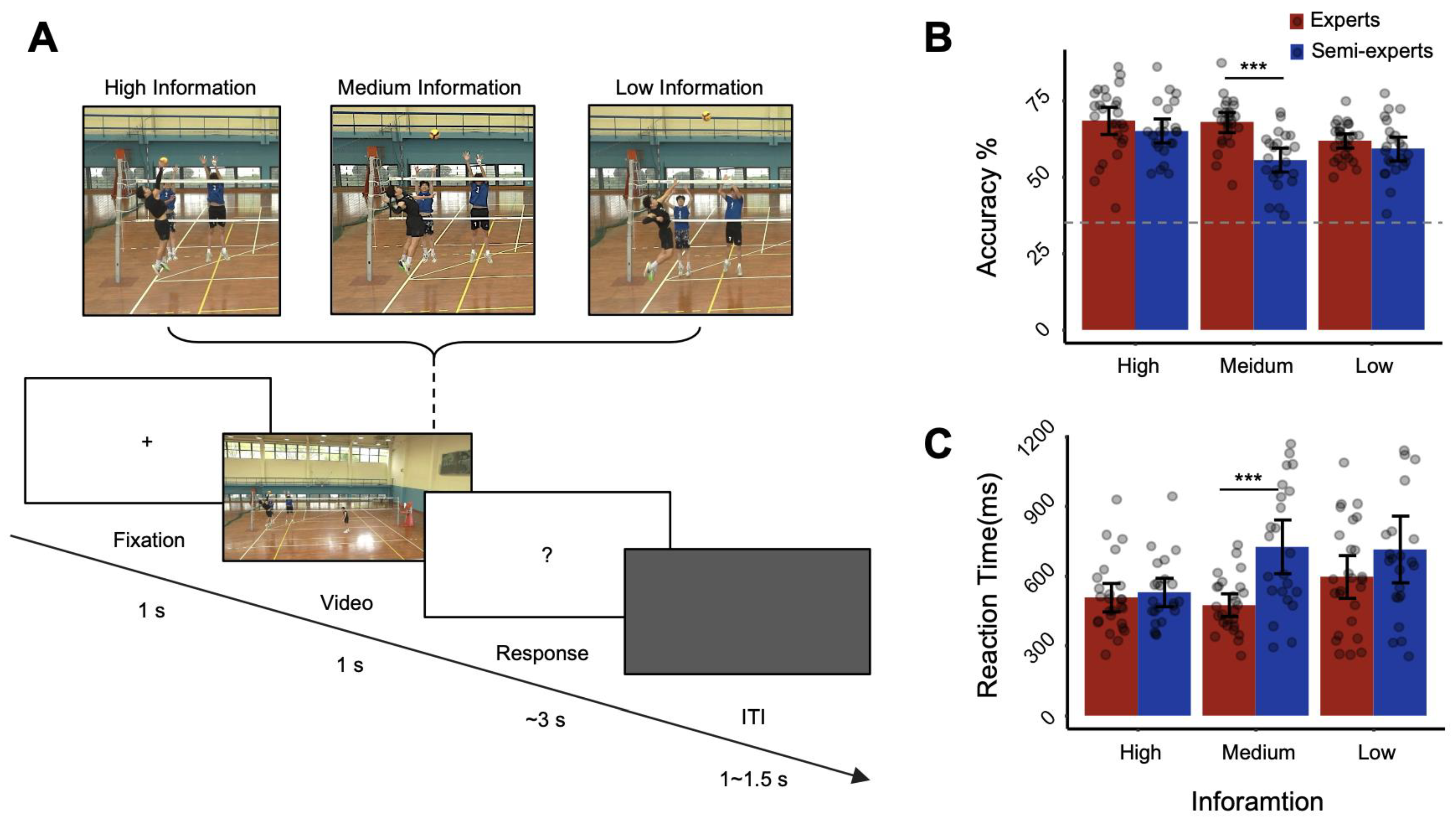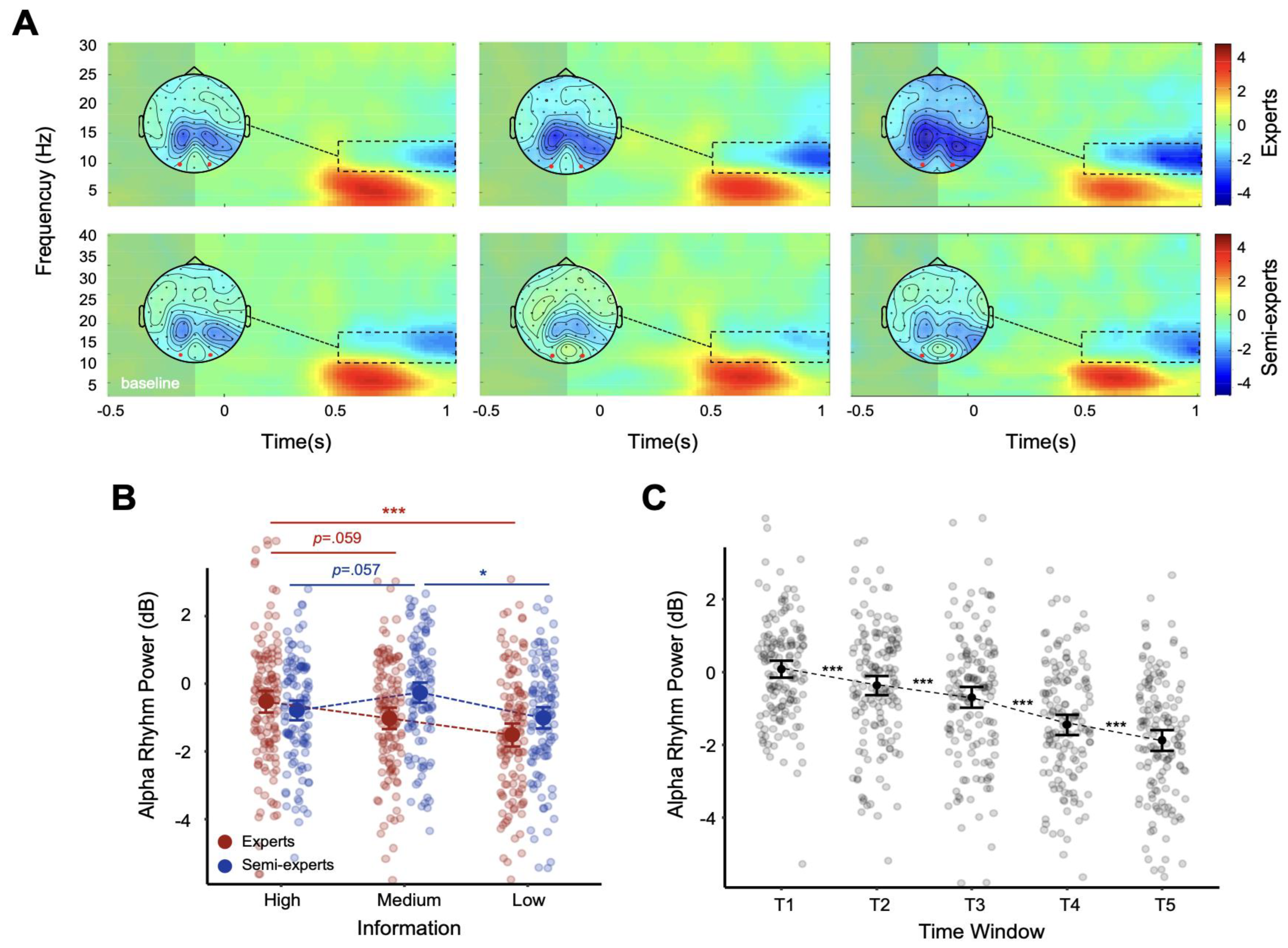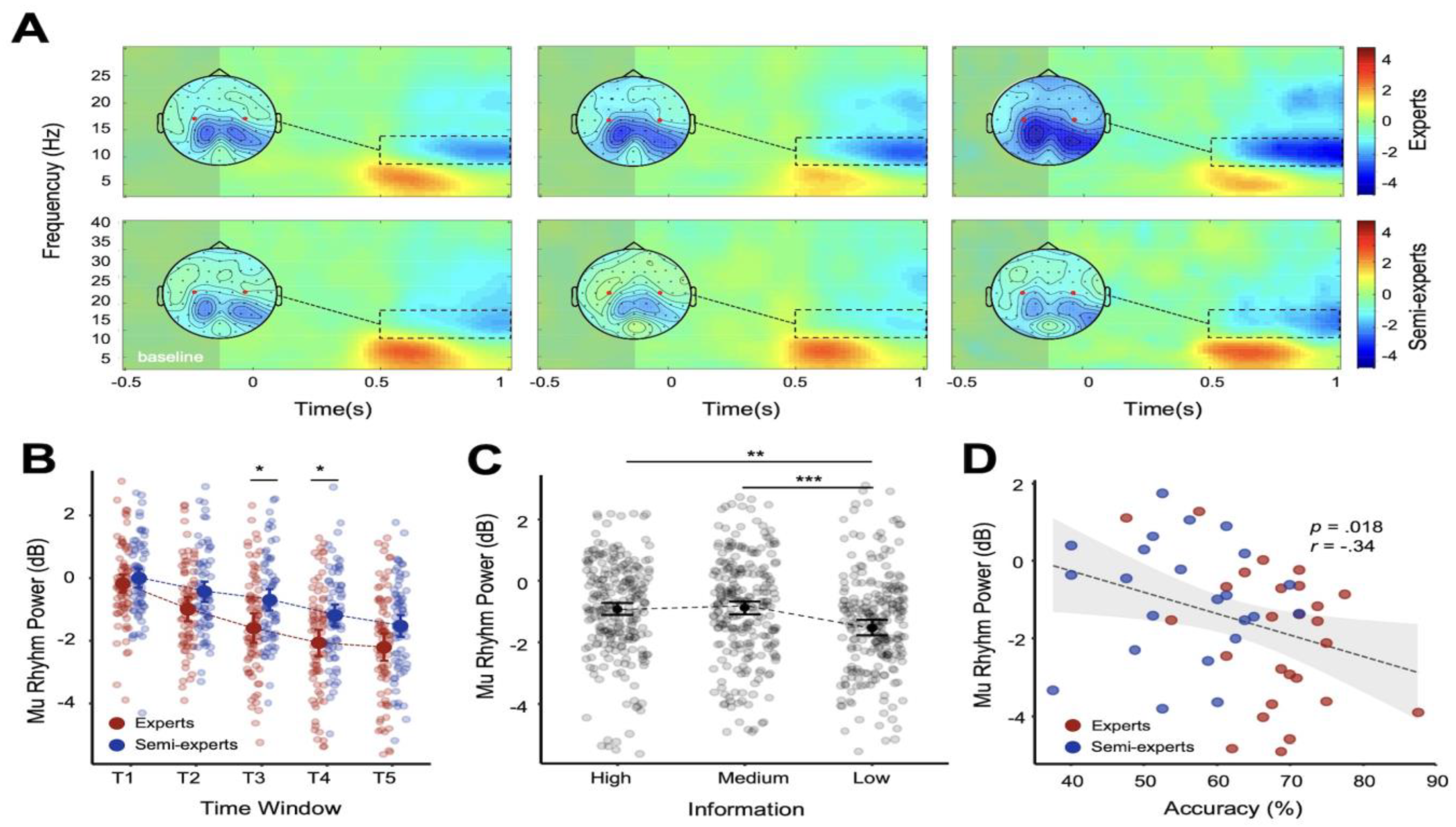Impacts of Kinematic Information on Action Anticipation and the Related Neurophysiological Associations in Volleyball Experts
Abstract
:1. Introduction
2. Materials and Methods
2.1. Participants
2.2. Materials
2.3. Design and Procedure
2.4. Data Analysis
2.4.1. Behavioral Data Analysis
2.4.2. EEG Data Acquisition and Preprocessing
2.4.3. EEG Data Time–Frequency Analysis
2.4.4. Statistical Analysis
3. Results
3.1. Behavioral Results
3.1.1. Accuracy
3.1.2. Reaction Time
3.2. Alpha Rhythm Study Results
3.3. Mu Rhythm Study Results
3.4. Correlation Analysis
4. Discussion
5. Limitations
6. Conclusions
Author Contributions
Funding
Institutional Review Board Statement
Informed Consent Statement
Data Availability Statement
Acknowledgments
Conflicts of Interest
References
- Voss, M.W.; Kramer, A.F.; Basak, C.; Prakash, R.S.; Roberts, B. Are expert athletes ‘expert’ in the cognitive laboratory? A meta-analytic review of cognition and sport expertise. Appl. Cogn. Psychol. 2010, 24, 812–826. [Google Scholar] [CrossRef]
- Yarrow, K.; Brown, P.; Krakauer, J.W. Inside the brain of an elite athlete: The neural processes that support high achievement in sports. Nat. Rev. Neurosci. 2009, 10, 585–596. [Google Scholar] [CrossRef] [PubMed]
- Müller, S.; Abernethy, B. Expert Anticipatory Skill in Striking Sports: A Review and a Model. Res. Q. Exerc. Sport 2012, 83, 175–187. [Google Scholar] [CrossRef] [PubMed]
- Müller, S.; Abernethy, B. Batting with occluded vision: An in situ examination of the information pick-up and interceptive skills of high- and low-skilled cricket batsmen. J. Sci. Med. Sport 2006, 9, 446–458. [Google Scholar] [CrossRef] [PubMed]
- Wright, M.J.; Bishop, D.T.; Jackson, R.C.; Abernethy, B. Brain regions concerned with the identification of deceptive soccer moves by higher-skilled and lower-skilled players. Front. Hum. Neurosci. 2013, 7, 851. [Google Scholar] [CrossRef] [PubMed]
- Balser, N.; Lorey, B.; Pilgramm, S.; Naumann, T.; Kindermann, S.; Stark, R.; Zentgraf, K.; Williams, A.M.; Munzert, J. The influence of expertise on brain activation of the action observation network during anticipation of tennis and volleyball serves. Front. Hum. Neurosci. 2014, 8, 568. [Google Scholar] [CrossRef] [PubMed]
- Schorer, J.; Wattie, N.; Baker, J.R. A new dimension to relative age effects: Constant year effects in German youth handball. PLoS ONE 2013, 8, e60336. [Google Scholar] [CrossRef]
- Urgesi, C.; Savonitto, M.M.; Fabbro, F.; Aglioti, S.M. Long- and short-term plastic modeling of action prediction abilities in volleyball. Psychol. Res. 2012, 76, 542–560. [Google Scholar] [CrossRef]
- Cañal-Bruland, R.; Mooren, M.; Savel sbergh, G.J.P. Differentiating Experts’ Anticipatory Skills in Beach Volleyball. Res. Q. Exerc. Sport 2011, 82, 667–674. [Google Scholar] [CrossRef]
- De Felice, S.; Hakim, U.; Gunasekara, N.; Pinti, P.; Tachtsidis, I.; Hamilton, A. Having a chat and then watching a movie: How social interaction synchronises our brains during co-watching. Oxf. Open Neurosci. 2024, 3, kvae006. [Google Scholar] [CrossRef]
- Zhao, Q.; Lu, Y.; Jaquess, K.J.; Zhou, C. Utilization of cues in action anticipation in table tennis players. J. Sports Sci. 2018, 36, 2699–2705. [Google Scholar] [CrossRef] [PubMed]
- Giustino, V.; Zangla, D.; Messina, G.; Pajaujiene, S.; Feka, K.; Battaglia, G.; Bianco, A.; Palma, A.; Patti, A. Kinematics of Cervical Spine during Rowing Ergometer at Different Stroke Rates in Young Rowers: A Pilot Study. Int. J. Environ. Res. Public Health 2022, 19, 7690. [Google Scholar] [CrossRef] [PubMed]
- Mann, D.L.; Nakamoto, H.; Logt, N.; Sikkink, L.; Brenner, E. Predictive eye movements when hitting a bouncing ball. J. Vis. 2019, 19, 28. [Google Scholar] [CrossRef] [PubMed]
- Williams, A.M.; Janelle, C.M.; Davids, K. Constraints on the search for visual information in sport. Int. J. Sport Exerc. Psychol. 2004, 2, 301–318. [Google Scholar] [CrossRef]
- Williams, A.M.; Jackson, R.C. Anticipation in sport: Fifty years on, what have we learned and what research still needs to be undertaken? Psychol. Sport Exerc. 2019, 42, 16–24. [Google Scholar] [CrossRef]
- Ottoboni, G.; Nicoletti, R.; Tessari, A. The Effect of Sport Practice on Enhanced Cognitive Processing of Bodily Indices: A Study on Volleyball Players and Their Ability to Predict Hand Gestures. Int. J. Environ. Res. Public Health 2021, 18, 5384. [Google Scholar] [CrossRef] [PubMed]
- Alves, H.; Voss, M.W.; Boot, W.R.; Deslandes, A.; Cossich, V.; Salles, J.I.; Kramer, A.F. Perceptual-cognitive expertise in elite volleyball players. Front. Psychol. 2013, 4, 36. [Google Scholar] [CrossRef] [PubMed]
- Zhu, R.; Zou, D.; Wang, K.; Cao, C. Expert Performance in Action Anticipation: Visual Search Behavior in Volleyball Spiking Defense from Different Viewing Perspectives. Behav. Sci. 2024, 14, 163. [Google Scholar] [CrossRef] [PubMed]
- Fox, N.A.; Baker mans-Kranenburg, M.J.; Yoo, K.H.; Bowman, L.C.; Cannon, E.N.; Vanderwert, R.E.; Ferrari, P.F.; van Ijzendoorn, M.H. Assessing human mirror activity with EEG mu rhythm: A meta-analysis. Psychol. Bull. 2016, 142, 291–313. [Google Scholar] [CrossRef]
- Wolf, S.; Brölz, E.; Scholz, D.; Ramos-Mur guialday, A.; Keune, P.M.; Hautzinger, M.; Birbaumer, N.; Strehl, U. Winning the game: Brain processes in expert, young elite and amateur table tennis players. Front. Behav. Neurosci. 2014, 8, 370. [Google Scholar] [CrossRef]
- Babiloni, C.; Del Percio, C.; Iacoboni, M.; Infarinato, F.; Lizio, R.; Marzano, N.; Crespi, G.; Dassù, F.; Pirritano, M.; Gallamini, M.; et al. Golf putt outcomes are predicted by sensorimotor cerebral EEG rhythms. J. Physiol. 2008, 586, 131–139. [Google Scholar] [CrossRef]
- Sutterer, D.W.; Polyn, S.M.; Woodman, G.F. α-Band activity tracks a two-dimensional spotlight of attention during spatial working memory maintenance. J. Neurophysiol. 2021, 125, 957–971. [Google Scholar] [CrossRef]
- Del Percio, C.; Brancucci, A.; Bergami, F.; Marzano, N.; Fiore, A.; Di Ciolo, E.; Aschieri, P.; Lino, A.; Vecchio, F.; Iacoboni, M.; et al. Cortical alpha rhythms are correlated with body sway during quiet open-eyes standing in athletes: A high-resolution EEG study. NeuroImage 2007, 36, 822–829. [Google Scholar] [CrossRef]
- Babiloni, C.; Del Percio, C.; Rossini, P.M.; Marzano, N.; Iacoboni, M.; Infarinato, F.; Lizio, R.; Piazza, M.; Pirritano, M.; Berlutti, G.; et al. Judgment of actions in experts: A high-resolution EEG study in elite athletes. NeuroImage 2009, 45, 512–521. [Google Scholar] [CrossRef]
- Babiloni, C.; Marzano, N.; Infarinato, F.; Iacoboni, M.; Rizza, G.; Aschieri, P.; Cibelli, G.; Soricelli, A.; Eusebi, F.; Del Percio, C. ‘Neural efficiency’ of experts’ brain during judgment of actions: A high-resolution EEG study in elite and amateur karate athletes. Behav. Brain Res. 2010, 207, 466–475. [Google Scholar] [CrossRef]
- Lu, Y.; Yang, T.; Hatfield, B.D.; Cong, F.; Zhou, C. Influence of cognitive-motor expertise on brain dynamics of anticipatory-based outcome processing. Psychophysiology 2020, 57, e13477. [Google Scholar] [CrossRef]
- DeCouto, B.S.; Smeeton, N.J.; Williams, A.M. Skilled Performers Show Right Parietal Lateralization during Anticipation of Volleyball Attacks. Brain Sci. 2023, 13, 1204. [Google Scholar] [CrossRef]
- Perry, A.; Stein, L.; Bentin, S. Motor and attentional mechanisms involved in social interaction—Evidence from mu and alpha EEG suppression. NeuroImage 2011, 58, 895–904. [Google Scholar] [CrossRef]
- Humphreys, G.W.; Sui, J. Attentional control and the self: The Self-Attention Network (SAN). Cogn. Neurosci. 2016, 7, 5–17. [Google Scholar] [CrossRef]
- Jannati, A.; Gaspar, J.M.; McDonald, J.J. Tracking target and distractor processing in fixed-feature visual search: Evidence from human electrophysiology. J. Exp. Psychol. Hum. Percept. Perform. 2013, 39, 1713–1730. [Google Scholar] [CrossRef]
- Kawasaki, M.; Yamaguchi, Y. Effects of subjective preference of colors on attention-related occipital theta oscillations. Neuro Image 2012, 59, 808–814. [Google Scholar] [CrossRef] [PubMed]
- Sui, J.; Liu, M.; Mevorach, C.; Humphreys, G.W. The salient self: The left intraparietal sulcus responds to social as well as perceptual-salience after self-association. Cereb. Cortex 2015, 25, 1060–1068. [Google Scholar] [CrossRef] [PubMed]
- Chikhi, S.; Matton, N.; Blanchet, S. EEG power spectral measures of cognitive workload: A meta-analysis. Psychophysiology 2022, 59, e14009. [Google Scholar] [CrossRef] [PubMed]
- Song, M.; Zhao, Q.; Du, C.; Zhou, C.; Li, R. The relationship between the accuracy of curling athletes’ duration judgment and delivery performance. PeerJ 2022, 10, e13541. [Google Scholar] [CrossRef] [PubMed]
- Del Percio, C.; Infarinato, F.; Marzano, N.; Iacoboni, M.; Aschieri, P.; Lizio, R.; Soricelli, A.; Limatola, C.; Rossini, P.M.; Babiloni, C. Reactivity of alpha rhythms to eyes opening is lower in athletes than non-athletes: A high-resolution EEG study. Int. J. Psychophysiol. Off. J. Int. Organ. Psychophysiol. 2011, 82, 240–247. [Google Scholar] [CrossRef] [PubMed]
- Filho, E.; Dobersek, U.; Husselman, T.-A. The role of neural efficiency, transient hypofrontality and neural proficiency in optimal performance in self-paced sports: A meta-analytic review. Exp. Brain Res. 2021, 239, 1381–1393. [Google Scholar] [CrossRef] [PubMed]
- Dicks, M.; Button, C.; Davids, K. Examination of gaze behaviors under in situ and video simulation task constraints reveals differences in information pickup for perception and action. Atten. Percept. Psychophys. 2010, 72, 706–720. [Google Scholar] [CrossRef] [PubMed]
- Bishop, D.T.; Wright, M.J.; Jackson, R.C.; Abernethy, B. Neural Bases for Anticipation Skill in Soccer: An fMRI Study. J. Sport Exerc. Psychol. 2013, 35, 98–109. [Google Scholar] [CrossRef] [PubMed]
- Calvo-Merino, B.; Glaser, D.E.; Grèzes, J.; Passingham, R.E.; Haggard, P. Action observation and acquired motor skills: An fMRI study with expert dancers. Cereb. Cortex 2005, 15, 1243–1249. [Google Scholar] [CrossRef]
- Wang, Y.; Lu, Y.; Deng, Y.; Gu, N.; Parviainen, T.; Zhou, C. Predicting domain-specific actions in expert table tennis players activates the semantic brain network. NeuroImage 2019, 200, 482–489. [Google Scholar] [CrossRef]
- Chen, Y.-H.; Chang, C.-Y.; Huang, S.-K.; Yen, N.-S. Nonlinear engagement of action observation network underlying action anticipation in players with different levels of expertise. Hum. Brain Mapp. 2020, 41, 5199–5214. [Google Scholar] [CrossRef] [PubMed]
- Chen, Y.-H.; Chang, C.-Y.; Huang, S.-K. Strike or ball? Batters know it better: An fMRI study of action anticipation in baseball players. Cereb. Cortex 2023, 33, 3221–3238. [Google Scholar] [CrossRef]
- Buszard, T. On Learning to Anticipate in Youth Sport. Sports Med. 2022, 52, 2303–2314. [Google Scholar] [CrossRef]
- De Waelle, S.; Warlop, G.; Lenoir, M.; Bennett, S.J.; Deconinck, F.J.A. The development of perceptual-cognitive skills in youth volleyball players. J. Sports Sci. 2021, 39, 1911–1925. [Google Scholar] [CrossRef]
- Yu, Y.; Zhang, L.; Cheng, M.-Y.; Liang, Z.; Zhang, M.; Qi, F. The Effects of Different Fatigue Types on Action Anticipation and Physical Performance in High-level Volleyball Players (p. 2023.11.26.568694). bioRxiv 2023, 13, 16–20. [Google Scholar] [CrossRef]
- Cheng, M.-Y.; Huang, C.-J.; Chang, Y.-K.; Koester, D.; Schack, T.; Hung, T.-M. Sensorimotor Rhythm Neurofeedback Enhances Golf Putting Performance. J. Sport Exerc. Psychol. 2015, 37, 626–636. [Google Scholar] [CrossRef] [PubMed]
- Onagawa, R.; Muraoka, Y.; Hagura, N.; Takemi, M. An investigation of the effectiveness of neurofeedback training on motor performance in healthy adults: A systematic review and meta-analysis. NeuroImage 2023, 270, 120000. [Google Scholar] [CrossRef]
- Sitaram, R.; Ros, T.; Stoeckel, L.; Haller, S.; Scharnowski, F.; Lewis-Peacock, J.; Weiskopf, N.; Blefari, M.L.; Rana, M.; Oblak, E.; et al. Closed-loop brain training: The science of neurofeedback. Nat. Rev. Neurosci. 2017, 18, 2. [Google Scholar] [CrossRef]



| Expert (n = 26) | Amateur (n = 23) | |
|---|---|---|
| Age | 20.38 ± 1.82 | 21.26 ± 2.33 |
| Years of Professional Training | 7.80 ± 2.70 | 3.36 ± 1.84 |
| Grades of Athletes | International Masters, n = 4 Grade 1 Athletes, n = 22 | Grade 2 Athletes, n = 3 No grade, n = 20 |
| Information Condition | Expert | Amateur | |
|---|---|---|---|
| M ± SD | M ± SD | ||
| Accuracy | High | 68.52 ± 10.93 | 65 ± 8.59 |
| Medium | 68 ± 7.77 | 55.1 ± 9.14 | |
| Low | 61.91 ± 5.87 | 59.55 ± 8.71 | |
| Response Time | High | 507.12 ± 150.91 | 528.83 ± 140.14 |
| Medium | 475.09 ± 115.67 | 725.81 ± 262.68 | |
| Low | 596.42 ± 225.63 | 714.94 ± 324.93 |
Disclaimer/Publisher’s Note: The statements, opinions and data contained in all publications are solely those of the individual author(s) and contributor(s) and not of MDPI and/or the editor(s). MDPI and/or the editor(s) disclaim responsibility for any injury to people or property resulting from any ideas, methods, instructions or products referred to in the content. |
© 2024 by the authors. Licensee MDPI, Basel, Switzerland. This article is an open access article distributed under the terms and conditions of the Creative Commons Attribution (CC BY) license (https://creativecommons.org/licenses/by/4.0/).
Share and Cite
Li, X.; Wang, D.; Gao, S.; Zhou, C. Impacts of Kinematic Information on Action Anticipation and the Related Neurophysiological Associations in Volleyball Experts. Brain Sci. 2024, 14, 647. https://doi.org/10.3390/brainsci14070647
Li X, Wang D, Gao S, Zhou C. Impacts of Kinematic Information on Action Anticipation and the Related Neurophysiological Associations in Volleyball Experts. Brain Sciences. 2024; 14(7):647. https://doi.org/10.3390/brainsci14070647
Chicago/Turabian StyleLi, Xizhe, Danlei Wang, Siyu Gao, and Chenglin Zhou. 2024. "Impacts of Kinematic Information on Action Anticipation and the Related Neurophysiological Associations in Volleyball Experts" Brain Sciences 14, no. 7: 647. https://doi.org/10.3390/brainsci14070647





